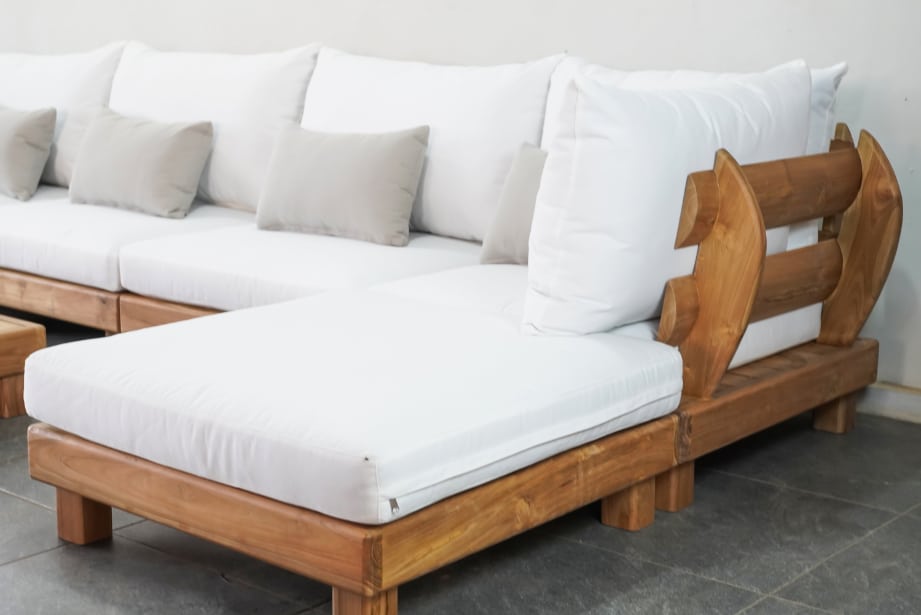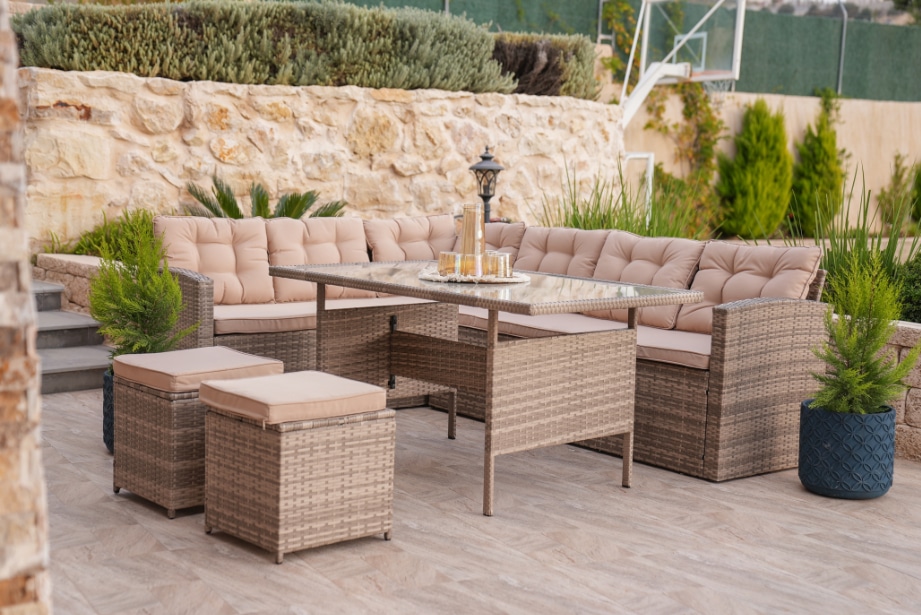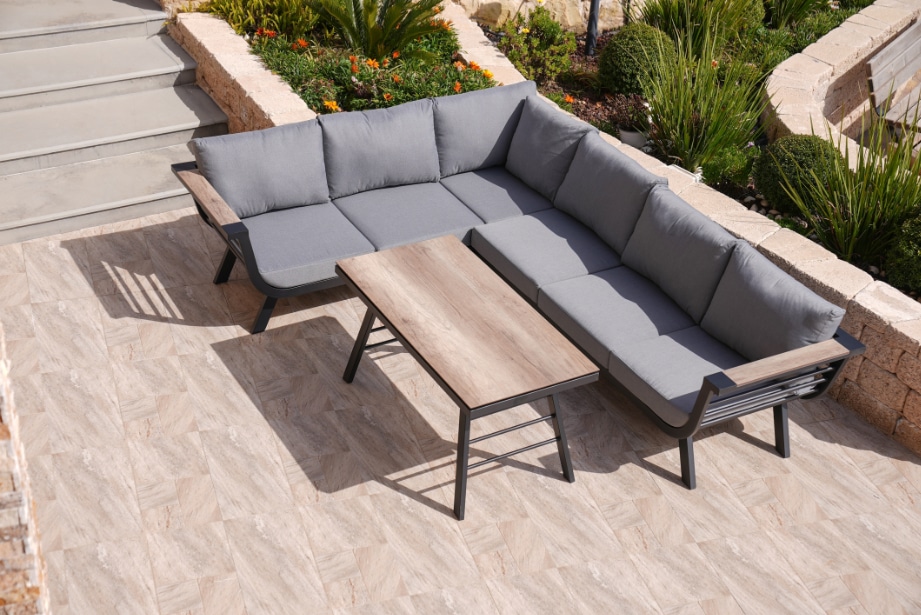Creating your perfect outdoor living space starts with choosing the right patio furniture material for your climate. Your choice can mean the difference between furniture that lasts for years and pieces that deteriorate quickly under harsh weather conditions.
Think about it: A beautiful teak dining set might look stunning in your backyard, but will it withstand the intense humidity of your coastal home? That sleek metal furniture could be perfect for your modern aesthetic, but how will it perform under the scorching summer sun?
We’ll dive deep into three popular patio furniture materials:
- Wood – Natural beauty meets durability
- Metal – Strong, weather-resistant options
- Wicker – Classic style with modern innovations
By understanding how each material performs in different climates, you’ll be equipped to make an informed decision that balances style, durability, and practicality. Let’s explore how these materials stand up to various weather conditions and help you find the perfect match for your outdoor space.
For instance, if you’re looking for a sturdy yet stylish option, Carolina Patio Furniture offers a variety of choices that blend luxury and comfort seamlessly. Whether you need a sailcloth salt patio set for those breezy beach days or a spectrum cherry set that adds a pop of color to your garden, they have you covered.
If you’re leaning towards metal furniture, it’s essential to choose pieces that are built to withstand the elements. On the other hand, if wicker is more your style, remember that modern innovations have made this material more durable and weather-resistant than ever before.
With these insights and options from Carolina Patio Furniture, you’re now better equipped to select the ideal patio furniture that complements your outdoor space while standing up to the test of time and weather.
Understanding Different Patio Furniture Materials
Selecting the right patio furniture material shapes your outdoor living experience. Each material brings distinct characteristics that affect durability, maintenance needs, and aesthetic appeal.
Key Material Characteristics:
Wood Furniture
- Natural aesthetic with rich grains and textures
- Varies in density and weather resistance
- Requires regular maintenance for longevity, as outlined in this patio furniture cleaning care guide for woods
- Sustainable when sourced responsibly
Metal Furniture
- High strength-to-weight ratio
- Resistant to extreme weather conditions
- Available in various finishes and styles
- Different metals offer unique benefits
Wicker Furniture
- Natural or synthetic fiber options
- Lightweight and easy to move
- Comfortable without additional cushioning
- Traditional to modern design versatility
Your climate plays a crucial role in material selection. Hot, humid environments demand materials resistant to moisture and UV damage, like those suggested in this article about best weather-resistant patio furniture materials for Atlanta’s humidity. Cold climates require furniture that won’t crack or deteriorate from freeze-thaw cycles.
Consider these factors when matching materials to your needs:
- Local weather patterns
- Available storage space
- Maintenance time commitment
- Desired lifespan
- Style preferences
- Budget constraints
The right material choice creates a balance between practicality and personal style, ensuring your patio furniture serves you well through changing seasons. For instance, if you’re located in Florida, you might want to explore the Pipe Collection – Cushion Dining Set or the Marvel Cloud which are designed to withstand such weather conditions. If you’re looking for dining sets specifically, the Pipe Collection – Dining Sets could be an excellent choice. Additionally, if you need a coffee table that complements your outdoor setting, consider our Sonoma Collection – Coffee Table, which combines style with functionality.
Moreover, if you’re considering a more sustainable option, you might want to look into poly outdoor furniture, which is known for its durability and low maintenance requirements.
Wood Patio Furniture: Natural Beauty and Warmth
Wood patio furniture brings timeless elegance and natural warmth to outdoor spaces. Three premium wood varieties stand out for their exceptional qualities:
1. Teak Wood
- Rich golden-brown color that weathers to a sophisticated silver-gray
- Natural oils resist rot, insects, and weather damage
- Dense grain structure prevents warping and splitting
- 50+ year lifespan with proper care
2. Cedar Wood
- Natural resistance to decay and insects
- Light weight makes furniture easy to move
- Distinctive reddish-brown color
- Affordable price point compared to teak
Maintaining cedar wood furniture requires specific care methods, which can be found in this comprehensive guide.
3. Acacia Wood
- Hard, durable surface resistant to scratches
- Beautiful dark grain patterns
- Water-resistant properties
- Sustainable fast-growing species
The natural beauty of wood furniture creates an inviting atmosphere that synthetic materials can’t match. Each piece develops unique character marks and patina over time, telling its own story through the years.
Maintaining wood patio furniture requires:
- Annual sealing or staining
- Regular cleaning with mild soap
- Protection from prolonged moisture
- Storage during harsh weather
While premium woods like teak command higher prices ($1,000-3,000 for dining sets), their longevity and timeless appeal make them cost-effective long-term investments. Cedar and acacia offer more budget-friendly options ($500-1,500) while still providing excellent durability and style.
For those looking to invest in quality wood patio furniture, consider exploring options such as the Bonita Collection – Sectional in Java With Fire Pit, or the Island Collection – 48″ Round Dining Table from Carolina Patio Furniture. These pieces not only embody the natural beauty of wood but also come with features designed to withstand various weather conditions, making them perfect for outdoor use.
When selecting wood for outdoor furniture, it’s essential to understand the characteristics of different types. This guide on choosing durable wood for outdoor furniture offers valuable insights into making the right choice for your patio furniture needs.
Metal Patio Furniture: Durable and Low Maintenance
Metal patio furniture stands out for its exceptional durability and minimal upkeep requirements. Three primary metals dominate the outdoor furniture market:
1. Cast and Extruded Aluminum
- Lightweight design makes rearranging your outdoor space effortless
- Naturally rust-resistant properties
- Powder-coated finishes add extra protection and color options
- Withstands rain, snow, and intense sun exposure
- Perfect for poolside areas due to moisture resistance
- An example of such a piece is the Aluminum Kona High back Sling Dining Chair, which is both stylish and functional.
2. Wrought Iron
- Classic, ornate designs with timeless appeal
- Extremely sturdy and wind-resistant
- Requires protective coating to prevent rust
- Heavier weight prevents furniture from blowing away
- Best suited for covered areas to minimize rust risk
3. Stainless Steel
- Modern, sleek aesthetic
- Superior corrosion resistance
- Higher price point reflects premium quality
- Heat retention can make seating uncomfortable in direct sun
- Ideal for contemporary outdoor spaces
Metal patio furniture excels in harsh weather conditions, from coastal environments to areas with frequent storms. The powder-coating technology used on aluminum pieces creates a protective barrier that maintains the furniture’s appearance while preventing oxidation. Stainless steel grades specifically designed for outdoor use offer enhanced resistance to environmental factors, making them suitable for year-round exposure to the elements.
If you’re looking for specific metal patio furniture pieces, consider exploring collections like the Bonita Collection Oak Chaise Lounge or the Vista Collection 48 Round Dining. For more casual settings, the Canvas Macaw or Canvas Granite could be perfect additions to your outdoor space.
Wicker Patio Furniture: Stylish Comfort with Care Considerations
Wicker patio furniture brings a timeless charm to outdoor spaces through its intricate weaving patterns and versatile design options. The material comes in two distinct varieties:
1. Natural Wicker
- Crafted from rattan, bamboo, or reed
- Delivers authentic aesthetic appeal
- Biodegradable and eco-friendly
- Requires indoor storage during harsh weather
- Best suited for screened porches or covered patios
2. Synthetic Wicker
- Made from high-density polyethylene (HDPE)
- UV-resistant and weatherproof
- Maintains color and structural integrity
- Withstands rain and humidity
- Minimal maintenance requirements
The lightweight nature of wicker furniture allows easy rearrangement of your outdoor space. You can clean both natural and synthetic wicker with a simple mixture of mild soap and water, making maintenance straightforward.
Natural wicker creates an organic, bohemian atmosphere but demands protection from rain and direct sunlight. The material excels in mild climates with low humidity levels. Synthetic alternatives offer similar aesthetic appeal with enhanced durability, making them suitable for various weather conditions.
The addition of weather-resistant cushions enhances both comfort and style, while proper storage during extreme weather extends the furniture’s lifespan. Covered areas provide ideal placement for wicker pieces, protecting them from direct exposure to harsh elements.
To further enhance your outdoor experience, consider incorporating wicker furniture accessories that complement your furniture. When selecting patio sets, the Grand Cypress Collection offers a perfect blend of style and functionality. For those who prefer a more modern design, the PKOY74 model could be an ideal choice.
Moreover, if you’re looking to add warmth to your outdoor space during cooler evenings, a Doral Square Fire Table can serve as a stylish and functional centerpiece.
Climate Considerations for Choosing the Right Patio Furniture Material
Your local climate plays a crucial role in determining the longevity of your patio furniture. Each material reacts differently to environmental factors:
High Humidity Environments
- Wood can warp and develop mold without proper sealing
- Aluminum resists moisture damage effectively
- Natural wicker may become brittle and prone to breaking
- Synthetic materials maintain structural integrity
Hot, Sunny Climates
- Metal furniture can become too hot to touch
- Dark-colored materials absorb more heat
- UV rays fade natural wood finishes
- Synthetic wicker may become brittle over time
Cold Weather Conditions
- Metal contracts in freezing temperatures
- Wood may crack from freeze-thaw cycles
- Wicker becomes more fragile in cold weather
- Powder-coated aluminum maintains stability
Coastal Areas
- Salt air corrodes untreated metal
- Teak wood naturally resists salt damage
- Synthetic materials offer best protection
- Regular cleaning becomes essential
Temperature Fluctuations
- Natural materials expand and contract
- Metal joints may loosen over time
- Quality synthetic materials maintain shape
- Protective covers help minimize damage
Your specific climate might combine several of these conditions. Consider the primary weather patterns in your area when selecting patio furniture materials. The right choice balances durability against your local environmental challenges.
For instance, if you’re located in Florida where high humidity is common, consider exploring options like these chairs that are designed to withstand such conditions. Alternatively, if you want to add some unique flair to your outdoor space, you might want to check out the Spectrum Caribou, which also offers great durability and style.
Maintenance Requirements per Material Type
Each patio furniture material demands specific care routines to maintain its beauty and durability. Here’s what you need to know about maintaining different materials:
Wood Maintenance
- Apply protective sealant every 6-12 months
- Sand surfaces lightly before resealing
- Clean with mild soap solution monthly
- Store indoors during harsh weather
- Check for loose joints or screws seasonally
- Remove fallen leaves promptly to prevent staining
Metal Care
- Wash with gentle soap and water regularly
- Apply rust-resistant coating annually
- Tighten loose hardware as needed
- Touch up scratches in powder coating promptly
- Keep wrought iron waxed to prevent oxidation
- Store in covered area during winter
Wicker Upkeep
- Vacuum between weaves weekly
- Wipe with damp cloth to remove dirt
- Use soft brush for stubborn debris
- Apply protective UV spray twice yearly
- Keep synthetic wicker covered when not in use
- Check for loose strands and repair promptly
Your maintenance schedule might need adjustment based on your local climate conditions and usage patterns. High-humidity areas require more frequent cleaning, while intense sun exposure means more frequent protective treatments. Creating a regular maintenance calendar helps extend your furniture’s lifespan and preserve its appearance through changing seasons.
Aesthetic Appeal, Comfort Factors, Budget Considerations & Sustainability in Material Selection
Each patio furniture material brings distinct aesthetic qualities and comfort levels to your outdoor space, paired with varying price points and environmental impacts.
Wood: Natural Elegance with Premium Value
- Rich, warm tones develop a distinguished patina
- Natural grain patterns create unique character
- Premium teak commands higher prices ($2,000-5,000 for dining sets)
- FSC-certified options ensure responsible forestry practices
- Ergonomic designs possible through skilled craftsmanship
Metal: Contemporary Style Meets Value
- Clean lines suit modern architectural designs
- Powder-coated finishes offer extensive color options
- Cast aluminum sets typically range $800-2,500
- Wrought iron pieces provide industrial charm
- Recyclable materials reduce environmental footprint
Wicker: Versatile Comfort with Style
- Intricate weaving patterns add visual interest
- Deep seating options with customizable cushions
- Natural fiber sets: $1,500-3,000
- Synthetic versions: $600-2,000
- Synthetic materials offer extended lifespan
Design Flexibility & Comfort Features
- Wood pieces accept custom cushions
- Metal furniture incorporates ergonomic curves
- Wicker naturally flexes for added comfort
- Mix-and-match potential across materials
- Weather-resistant fabric options for all styles
Sustainability Considerations
- Reclaimed wood options reduce deforestation
- Recycled metal content in aluminum pieces
- Natural wicker sourced from renewable rattan
- Local manufacturing reduces carbon footprint
- Durability extends product lifecycle
Budget-Smart Selection Tips
- Start with key pieces, expand collection gradually
- Consider off-season purchases for savings
- Evaluate warranty coverage
- Factor maintenance costs into total investment
- Balance initial cost against longevity
Your choice impacts both immediate comfort and long-term value. High-quality materials paired with proper care create lasting outdoor spaces that reflect your style while respecting environmental considerations.
Expert Recommendations Based on Climate Zones
Different climate zones require specific materials to ensure durability and performance. Here’s what experts recommend for different climate types, based on the best material for outdoor furniture:
Hot and Dry Climates
- Cast aluminum is the top choice
- Compared to other metals, it retains minimal heat
- Powder-coated finishes resist sun damage
- Even in direct sunlight, the natural color stays cool
Hot and Humid Environments
- Aluminum remains the gold standard
- Complete rust resistance makes it ideal for coastal areas
- With proper care, teak performs exceptionally well
- Style and durability are provided by synthetic wicker with aluminum frames
Mild Climate Zones
- All three materials perform well with basic maintenance
- Natural wicker creates a perfect indoor-outdoor flow
- Over time, wood furniture develops beautiful patina
- Minimal upkeep is required for metal pieces
Extreme Weather Regions
- Heavy wrought iron resists strong winds
- Moisture damage is combated by teak’s natural oils
- Temperature fluctuations are withstood by cast aluminum
- Cracking in freezing conditions is prevented by synthetic materials
Coastal Areas
- Salt air corrosion is fought by marine-grade stainless steel
- Appearance is maintained by powder-coated aluminum
- Salt damage is resisted by high-density polyethylene wicker
- Moisture and salt are combated by teak’s natural properties
Seasonal Considerations
- Wicker should be stored indoors during harsh winters
- Protective covers should be applied to wood during rainy seasons
- Lightweight aluminum, such as that used in the Casita Aluminum Daybed, should be chosen for easy seasonal storage
- Cushion fabrics that are weather-resistant should be selected to match material durability
Your specific microclimate plays a crucial role in material selection. Local weather patterns, sun exposure, and seasonal changes impact furniture longevity. Regardless of material choice, consider covered storage options or protective furniture covers to extend the life of your outdoor pieces.
Conclusion
Choosing the right material for your patio furniture requires careful consideration of both your personal style and the climate in your area. The weather conditions where you live will greatly impact how long your outdoor furniture lasts and how well it performs.
Keep these important factors in mind when making your decision:
- Wood adds a natural and elegant touch, with teak being the best option for different climates
- Metal furniture is extremely durable and requires little maintenance
- Wicker creates a comfortable atmosphere but needs to be placed strategically and protected from the elements
By selecting the appropriate material, you can turn your outdoor space into a beautiful retreat that can withstand any weather. Take the time to assess your specific climate conditions, maintenance preferences, and design vision. Making an informed choice will result in many years of enjoyment in your outdoor living area.
Remember: The most stunning patio furniture will only stay attractive if it can endure the weather challenges in your area. Let your climate influence your choice of material while incorporating your personal style into the specific design elements.




